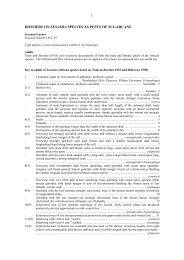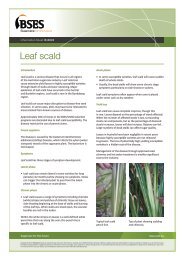You also want an ePaper? Increase the reach of your titles
YUMPU automatically turns print PDFs into web optimized ePapers that Google loves.
7<br />
risk Of iNTrODuCTiON<br />
The movement of infected planting<br />
material or transport of insects (carried<br />
by aircraft or freight from PNG) pose the<br />
greatest risks of this disease spreading to<br />
Australia. The risk of an incursion by an<br />
infected insect is high in the Torres Strait<br />
islands because some islands are only a<br />
short distance from the southern PNG<br />
coastline. Sugarcane is a common garden<br />
plant in both the Torres Strait and PNG, also<br />
people sell or exchange gifts of sugarcane.<br />
AQIS and Biosecurity Queensland<br />
have active programs in the Torres Strait<br />
to monitor the potential spread of<br />
diseases like Ramu stunt and to control<br />
the movement of plants and animals in<br />
that area of Australia.<br />
CONTrOL<br />
Scientists introduced resistant cane<br />
varieties to the Ramu Estate in PNG and<br />
successfully controlled the Ramu stunt<br />
epidemic. Australia and other countries<br />
have bred varieties with high levels of<br />
resistance to Ramu stunt, and <strong>BSES</strong> holds<br />
some of these in its variety collections.<br />
for many years <strong>BSES</strong>, in cooperation with<br />
the Ramu sugar plantation, has screened<br />
Australian varieties grown in PNG for<br />
resistance to this disease. Most Australianbred<br />
varieties possess a high level of<br />
resistance – only <strong>25</strong>% exhibit symptoms<br />
of the disease in screening tests when<br />
exposed to high infection pressure.<br />
IMAGE 1 | leaf symptoms of Ramu stunt on the wild cane Saccharum robustum.<br />
IMAGE 2-3 | leaf symptoms on the variety ‘Yassawa’.<br />
IMAGE 4 | Symptoms of Ramu stunt in a susceptible sugarcane variety in a trial<br />
at Gusap, PNG.<br />
IMAGE 5 | Typical stunting of cane stool in the susceptible variety Q124.<br />
IMAGE 6 | Stunting in the variety ‘Pindar’ (diseased foreground, healthy stool<br />
in background).<br />
IMAGE 7 | Planthopper, Eumetopina flavipes, adult and immature stages in the<br />
leaf whorl (PNG).<br />
A new SRDC-funded project aims to improve<br />
the methods of screening for resistance to<br />
Ramu stunt and ensure that all new <strong>BSES</strong><br />
varieties are rated for resistance. <strong>BSES</strong> has<br />
developed a contingency plan in case of an<br />
incursion of Ramu stunt, and the knowledge<br />
of the levels of resistance in Australian<br />
varieties is vital to this plan.<br />
unlike smut, there is a good chance of<br />
eradicating Ramu stunt should it ever enter<br />
Australia. Early identification of an outbreak<br />
greatly lifts the chances of eradicating the<br />
disease. Remember, signs of any unusual<br />
symptoms in crops that growers suspect may<br />
indicate the presence of an exotic disease<br />
should be immediately reported to the<br />
nearest <strong>BSES</strong> office or on the Exotic Plant<br />
Pest Hotline (1800 084 881)!<br />
p 1 5 i s s u e 2 5




